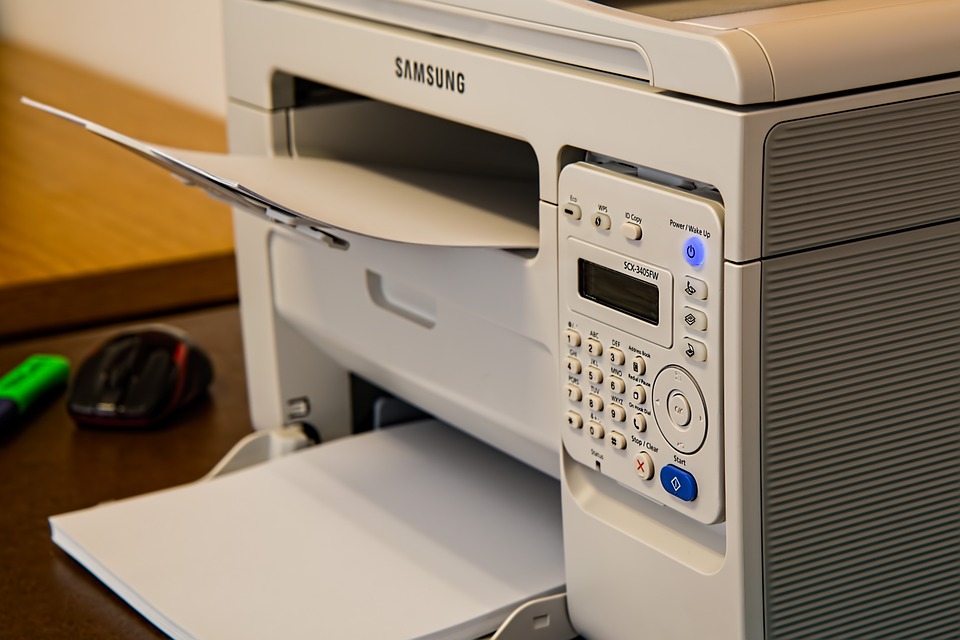
image via: pixabay.com
When shopping for heat press supplies, you've probably come across something called sublimation paper. But if you're new to the world of transfer paper and heat presses, you might be wondering: What is sublimation paper?
That is an extremely common question within the heat press community and one we've all had to learn at some point!
In short, sublimation paper is a specialty printing paper that absorbs and holds ink. When placed on a blank surface (like a t-shirt, piece of vinyl, mouse pad, or other material) and heated, the sublimation paper releases the ink onto the material. This process allows you to indirectly print on all different materials and products.
On the one hand, sublimation paper is an extremely quick and easy way to create your own personalized t-shirts and other goods. Everyone from home crafters to professional printers uses this process.
But if you want to ensure high-quality results from your sublimation paper, you need to know a bit about how this paper works and the best methods for using it.
The Science Behind Sublimation Paper

IMAGE BY:PIXABAY
So what is sublimation paper exactly? To best answer this question, I think you should first learn how sublimation paper actually works.
Sublimation paper is made up of paper and a special polyester coating. This coating is key to holding the ink within the paper.
When it comes to printing on this paper, the process is much like using your home printer and normal printer paper. While sublimation printers use inkjets for printing, you can't use just any ink.
You need to use specialized sublimation inks with sublimation paper. Without this specialty ink, your transfer project will fail.
The magic of sublimation paper happens when the paper is placed on a blank surface and heated. When heated, sublimation ink temporarily transforms into a gas. At the same time, pores in the polyester coating expand to allow this gaseous ink to escape the paper and deposit onto the blank surface.
If you're still confused, think of sublimation paper as a temporary holding cell for your printed image. The point isn't to have your image stay on the paper permanently. Instead, it is just holding onto the ink until it can be deposited onto your t-shirt or other material of choice.
How To Get The Best Results From Sublimation Paper

IMAGE BY:PIXABAY
Knowing the scientific answer to "What is sublimation paper?" isn't enough to get great results with this printing method. You also need to know a bit about how to choose the right materials and printer, as well as how to properly transfer and care for your new items.
If your sublimation paper of choice offers instructions that differ from those below, go ahead and follow the manufacturer's guidelines. But for most sublimation paper, these tips will help you get high-quality results every time.
Materials
If you're planning your own sublimation transfer project, you might wonder what is sublimation paper used for when it comes to materials.
Well, just like sublimation paper itself uses a polyester coating to capture the ink, your printable materials must also contain polyester or another polymer. Fortunately, polymers are one of the most common and versatile materials out there.
Polyester t-shirts are easy to find and make a great canvas for sublimation paper. You can also find items like mugs, jewelry, coasters, and more that feature a poly-coating. All of these items are good candidates for printing with sublimation paper.
Transferring
After printing your image on the sublimation paper, you can begin the transfer process. That is where your heat press comes in.
For most brands of sublimation paper, you'll need to heat your press to 375 to 400 degrees. However, this can vary, so make sure to double-check the products you've chosen for your project.
To prepare your printing surface, press for three to five seconds to release excess moisture and eliminate wrinkles. Then, securely place your sublimation paper, image side down. Place Teflon or parchment paper on top of the sublimation paper.
Depending on your exact project, you'll probably need to let the transfer process for 30 to 120 seconds. Once the transfer is complete, though, you want to remove the project from the heat press as quickly as possible.
Care
To keep your sublimation transfer project looking great for as long as possible, you'll want to follow some simple care instructions.
Since heat is such an integral part of the transfer process, you typically want to avoid applying heat to your finished project. That includes washing it in cold water and avoiding contact with irons, dishwashers, and more. You should also keep the time your project is in water to a minimum.
If you can, such as with a t-shirt, turn your project inside-out before washing. It will help the design last even longer.
Troubleshooting Your Sublimation Paper Issues

IMAGE BY:PIXABAY
Even if you follow the above tips and your sublimation paper's instructions perfectly, you might have issues getting the best results on your first couple attempts. Fortunately, troubleshooting these issues is normally pretty easy.
When it comes to lackluster transfer results, what is sublimation paper most likely to have go wrong?
Incorrect colors
If your final colors aren't turning out the way you expected, it might not be a problem with your paper. Instead, the problem is likely with the calibrating between your computer and printer.
Even with normal printing, colors often don't match those seen on the screen. One of the best ways to fix this is to ensure your design uses CMYK.
CMYK is the color system used in printing. But most digital programs use RGB or another color system. When you try to print an RGB file on your computer, which only understands CMYK, your computer automatically translates these colors to the correct color system. Unfortunately, this translation is rarely perfect.
Another cause of incorrect colors in your sublimation printing process could be your ink itself. Double-check the age of your ink, as sublimation ink typically only lasts for about a year after opening.
Banding
Just like your typical office printer, sublimation printers can encounter issues with banding. When this happens, your printer leaves light bands across the entire image, effectively making it unusable for your intended project.
And, just like in your office printer, the likely culprit is one or more clogged inkjet nozzle heads. Clogs frequently occur when the printer sits idle for a while and the ink dries out.
If you use your sublimation printer regularly, you might not encounter banding at all. But for those who only use their printer for special projects, this is a common issue.
We suggest using your printer's head cleaning function. Depending on your model, you might be able to set up automatic timed intervals for these cleanings. Some models, though, require the manual press of a button.
Ghosting
What is sublimation paper ghosting? Ghosting is when a transferred image has a lighter version of itself layered askew to the correctly printed one.
Ghosting typically occurs when the sublimation paper or project surface shifts during the heat pressing process. The result is a "ghost" of the image, usually just a few centimeters off from the correctly printed image.
To prevent ghosting in your own projects, you need to keep your sublimation paper and printing surface from shifting throughout the transfer process. Two of the best products for this are heat-resistant tape or spray adhesive.
When removing the sublimation paper after transferring, ghosting can also occur if you accidentally shift the paper against your project. Use care to remove the paper straight up from your printed surface to prevent this issue.
What Is Sublimation Paper?: Q&A

IMAGE BY:PIXABAY
Here are a few related questions you might be interested in, as well:
Can you use sublimation paper in a normal printer?
No, sadly, a typical home office printer won't work with sublimation paper. At least, not if you want to get great results. However, you don't have to commit to a huge, industrial-sized printer if you want to try sublimation transfers at home.
You can find several high-quality, desktop-style sublimation printers for home use on the market today. While these printers won't hold up to the demand of a professional printing business, they're perfect for hobbyists or small business owners.
Are sublimation paper and heat transfer paper the same thing?
Although sublimation paper and heat transfer paper produce pretty similar results, they are not the same and do not work the same. So what is sublimation paper doing differently than heat transfer paper?
With sublimation transfers, the only thing transferring onto the finished product is the ink. But with heat transfer paper, it's not just the ink being transferred to the garment or another item. Heat transfer paper features a layer of polymer which fully transfers to the final product.
That is why products made using heat transfer paper often have a slightly tacky or stiff texture where the design sits.
How long does sublimation paper last?
Unlike normal printer paper, sublimation paper doesn't last forever. But what is sublimation paper's standard shelf life?
If stored in a cool, dark place, you can expect your sublimation paper to remain in good condition for about a year. When it comes to keeping your sublimation paper in like-new condition for as long as possible, make sure to avoid exposure to moisture and heat.
Take Your Heat Press Skills To The Next Level

image via: pixabay.com
What is sublimation paper and what do you use it for? Now you know!
Combined with a high-quality heat press, sublimation paper is one of the most versatile products you can add to your crafting arsenal. Although purchasing a sublimation printer can be a bit pricey, you can create all types of products with just this one tool.
Since you can use this paper on anything with a polyester or polymer coating, you can create truly one-of-a-kind mugs, keychains, shirts, bags, puzzles, and more. If you're someone who loves creating, whether for profit or for fun, we think mastering the art of sublimation printing is a worthwhile investment.
Do you have personal experience using sublimation paper? Share your wisdom in the comments!
